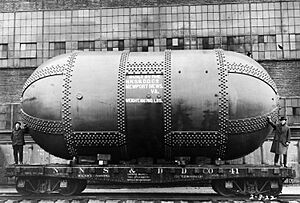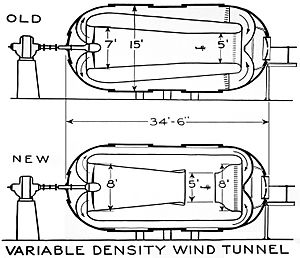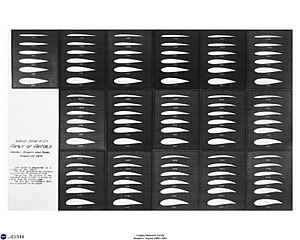Variable Density Tunnel facts for kids
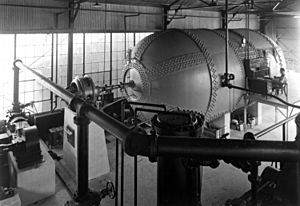
The Variable Density Tunnel at Langley Research Center with the drive motor (left), compressor piping (front), and an operator (right).
|
|
| Acronym | VDT |
|---|---|
| Other names | Wind Tunnel No. 2 |
| Uses | Measuring aerodynamic qualities of airfoils |
| Notable experiments | "NACA Technical Report 460: The Characteristics of 78 Related Airfoil Sections from Tests in the Variable-Density Wind Tunnel" |
| Inventor | Max Munk |
| Manufacturer | Newport News Shipbuilding and Dry Dock Company |
| Material | Steel, wood |
| Components | Steel pressure shell, air compressor, drive motor, internal test section |
| Related items | NACA, Langley Research Center |
The Variable Density Tunnel (VDT) was a very important wind tunnel at the Langley Research Center. This center was part of the National Advisory Committee for Aeronautics (NACA), which later became NASA.
A German engineer named Max Munk suggested building it in 1921. It was the first wind tunnel in the world that could change the air's density. This made it possible to test small models much more accurately than before.
The VDT was used a lot from 1923 until the 1940s. Historians say it gave better results than other wind tunnels at the time. It helped NACA become a world leader in studying how air moves around things. Today, the VDT is on display at Langley and is a National Historic Landmark.
Contents
Why the VDT Was So Important
To test small models of aircraft accurately, scientists need to make sure the air in the wind tunnel acts just like real air. This means the air's density needs to be scaled correctly.
Imagine you have a small model of an airplane wing. When you test it in a wind tunnel, the air needs to behave as if it were flowing around a full-sized wing. If the air isn't dense enough, the test results won't be correct.
Older wind tunnels could only work with normal air pressure. This meant that the air flowing over a small model didn't act like it would for a real, full-sized airplane. The Variable Density Tunnel fixed this problem. It was built to be pressurized, meaning it could make the air inside much denser. By increasing the air's density, the VDT could accurately show how air would react with a full-sized aircraft. This helped scientists get much more accurate measurements of how air affects planes.
How the VDT Was Built
Its Beginning
In 1920, NACA brought Max Munk, a smart German aerospace engineer, to work in America. Munk had some trouble getting used to NACA's way of doing things. But he still came up with his amazing idea for the Variable Density Tunnel that same year.
The VDT had a huge steel tank that could hold air at very high pressure. It was built by the Newport News Shipbuilding and Dry Dock Company in Newport News, Virginia. The tank was about 34.5 ft (10.5 m) long and 15 ft (4.6 m) wide. Its walls were over 2 in (51 mm) thick and it weighed 85 tons (77.3 tonnes) of steel.
The part where models were tested was 5 ft (1.5 m) wide. A powerful 250-horsepower motor ran a fan that could make the air move up to 51 mph (82 km/h).
In 1927, a fire damaged the VDT's inside wooden parts. It was rebuilt, but then had to be rebuilt again to work correctly. The VDT started working again in 1930. It kept helping scientists measure how air affects wings until the 1940s, when newer tunnels were built. The VDT was officially stopped in 1978. In 1985, it was named a National Historic Landmark because it helped lay the groundwork for space travel.
What the VDT Was Used For
The VDT was used for research for over 20 years. It mainly helped test different shapes of airplane wings, called airfoils. Designing better wings was a big challenge in the early days of aviation.
The VDT collected important information for 78 classic airfoil shapes. This data was published in 1933 in a report called "The Characteristics of 78 Related Airfoil Sections from Tests in the Variable-Density Wind Tunnel." This information was used to design many famous American planes from World War II. These included the Douglas DC-3, the Boeing B-17 Flying Fortress, and the Lockheed P-38 Lightning. The VDT also helped design thin, low-drag wings used for planes like the P-51 Mustang. These new designs helped reduce air resistance by a lot.
A National Historic Landmark
On October 3, 1985, the United States National Park Service recognized the Variable Density Tunnel as a National Historic Landmark. They said the VDT helped make NACA a top research group. It also helped improve American aviation research, which led to some of the best aircraft in the world.
The building where the VDT was originally located was taken down in 2014. But the main tank of the VDT is still on display at the Langley grounds.
|
Variable Density Tunnel
|
|
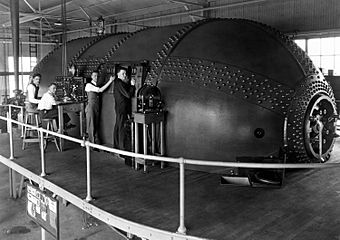
1929 photograph of the Variable Density Tunnel, Eastman Jacobs is at far left.
|
|
| Location | Hampton, Virginia |
|---|---|
| Built | 1921-1923 |
| Architect | Max Munk |
| NRHP reference No. | 85002795 |
| Significant dates | |
| Added to NRHP | October 3, 1985 |
| Designated NHL | October 3, 1985 |


